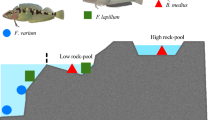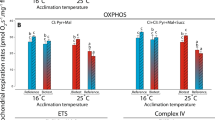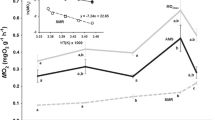Abstract
The heart is acutely sensitive to temperature in aquatic ectotherms and appears to fail before any other organ as the thermal maximum is reached, although the exact cause of this failure remains unknown. The heart is highly aerobic and therefore dependent on mitochondrial oxidative phosphorylation (OXPHOS) to meet energy requirements, but the role of cardiac mitochondria in limiting heart function at high temperatures remains unclear. We used permeabilised ventricle fibres to explore heart mitochondrial function in situ in three closely related species of small New Zealand triplefin fishes in response to temperature. We compared this to measures of whole animal respiration rates and critical oxygen tensions in these fishes. Bellapiscis medius, an intertidal species, had the greatest tolerance to hypoxia at higher temperatures and had more efficient OXPHOS at 30°C than the two subtidal species Forsterygion varium and F. malcolmi. B. medius also displayed the highest cytochrome c oxidase flux, which may in part explain how B. medius tolerates higher temperatures and hypoxia. Triplefin heart mitochondria exhibit decreased coupling to phosphorylation with increasing temperature. This most likely impairs ATP supply to the heart at elevated temperatures, potentially contributing to heart failure at ecologically relevant temperatures.






Similar content being viewed by others
Abbreviations
- ADP:
-
Adenosine-5′-diphosphate
- ATP:
-
Adenosine-5′-triphosphate
- BSA:
-
Bovine serum albumin
- CCO:
-
Cytochrome c oxidase
- CCOc :
-
Cytochrome c oxidase in the presence of additional cytochrome c
- EGTA:
-
Ethylene glycol tetraacetic acid
- ETS:
-
Electron transport system
- FADH2 :
-
Flavin adenine dinucleotide (reduced)
- FCCP:
-
Carbonyl cyanide p-(trifluoro-methoxy) phenyl-hydrazone
- HEPES:
-
Na N-2-hydroxyethylpiperazine-N′-2-ethanesulfonic acid
- JO 2 :
-
Rate of mitochondrial oxygen consumption
- LSLR:
-
Least squares linear regression
- MES:
-
2-(N-morpholino) ethanesulfonic acid
- NADH:
-
Nicotinamide adenine dinucleotide (reduced)
- OXPHOS:
-
Oxidative phosphorylation
- RCR:
-
Respiratory control ratio
- ROS:
-
Reactive oxygen species
- TMPD:
-
N,N,N′,N′-tetramethyl-p-phenyldiamine
- VO 2 :
-
Rate of oxygen consumption
References
Abele D, Philipp E, González PM, Puntarulo S (2007) Marine invertebrate mitochondria and oxidative stress. Front Biosci 12:933–946
Almeida-Val VMF, Buck LT, Hochachka PW (1994) Substrate and acute temperature effects on turtle heart and liver mitochondria. Am J Physiol 266R:858–862
Antunes F, Boveris A, Cadenas E (2004) On the mechanism and biology of cytochrome oxidase inhibition by nitric oxide. PNAS 101:16774–16779
Benard G, Faustin B, Passerieux E, Galinier A, Rocher C, Bellance N, Delage J-P, Casteilla L, Letellier T, Rossignol R (2006) Physiological diversity of mitochondrial oxidative phosphorylation. Am J Physiol 291C:1172–1182
Birkedal R, Gesser H (2003) Creatine kinase and mitochondrial respiration in hearts of trout, cod and freshwater turtle. J Comp Physiol 173B:493–499
Borutaite V, Brown G (1996) Rapid reduction of nitric oxide by mitochondria, and reversible inhibition of mitochondrial respiration by nitric oxide. Biochem J 315:295–299
Boushel R, Gnaiger E, Schjerling P, Skovbro M, Kraunsoe R, Dela F (2007) Patients with type 2 diabetes have normal mitochondrial function in skeletal muscle. Diabetalogia 50:790–796
Brand MD, Chien L-F, Ainscow EK, Rolfe DFS, Porter RK (1994) The causes and functions of mitochondrial proton leak. Biochim Biophys Acta 1187:132–139
Brookes PS, Buckingham JA, Tenreiro AM, Hulbert AJ, Brand MD (1998) The proton permeability of the inner membrane of liver mitochondria from ectothermic and endothermic vertebrates and from obese rats: correlations with standard metabolic rate and phospholipid fatty acid composition. Comp Biochem Physiol 119B:325–334
Cadenas S, Buckingham J, St Pierre J, Dickinson K, Jones R, Brand M (2000) AMP decreases the efficiency of skeletal-muscle mitochondria. Biochem J 351:307–311
Caldwell RS, Vernberg FJ (1970) The influence of acclimation temperature on the lipid composition of fish gill mitochondria. Comp Biochem Physiol 34:179–191
Campian JL, Gao X, Qian M, Eaton JW (2007) Cytochrome c oxidase activity and oxygen tolerance. J Biol Chem 282:12430–12438
Cereghetti GM, Scorrano L (2006) The many shapes of mitochondrial death. Oncogene 25:4717–4724
Chance B, Hagihara B (1962) Activation and inhibition of succinate oxidation following adenosine diphosphate supplements to pigeon heart mitochondria. J Biol Chem 237:3540–3545
Chemnitius J, Manglitz T, Kloeppel M, Doenst T, Schwartz P, Kreuzer H, Zech R (1993) Rapid preparation of subsarcolemmal and interfibrillar mitochondrial subpopulations from cardiac muscle. Int J Biochem 25:589–596
Clements KD (2003) Triplefins. In: Andrew N, Francis MP (eds) The living reef: the ecology of New Zealand’s rocky reefs. Craig Potton Publishing, Nelson, pp 160–167
Cossins AR, Kent J, Prosser CL (1980) A steady state and differential polarised phase fluorimetric study of the liver microsomal and mitochondrial membranes of thermally acclimated green sunfish (Lepomis cyanellus). Biochim Biophys Acta 599:341–358
Dahlhoff E, Somero GN (1993) Effects of temperature on mitochondria from abalone (Genus Haliotis): adaptive plasticity and its limits. J Exp Biol 185:151–168
Das NB (1937) Studies on the inhibition of the succinic and lactic-malic dehydrogenases. Biochem J 31:1124–1130
Davidson S, Duchen M (2006) Effects of NO on mitochondrial function in cardiomyocytes: pathophysiological relevance. Cardiovasc Res 71:10–21
Di Paola M, Lorusso M (2006) Interaction of free fatty acids with mitochondria: coupling, uncoupling and permeability transition. Biochim Biophys Acta 1757:1330–1337
Farrell AP (1997) Effects of temperature on cardiovascular performance. In: Wood CM, Mc Donald DG (eds) Global warming: implications for freshwater and marine fish. Cambridge University Press, Cambridge, pp 135–158
Farrell AP (2002) Cardiorespiratory performance in salmonids during exercise at high temperature: insights into cardiovascular design limitations in fishes. Comp Biochem Physiol 132A:797–810
Feary DA, Clements KD (2006) Habitat use by triplefin fishes (Family Trypterygiidae) on rocky reefs in New Zealand. J Fish Biol 69:1031–1046
Frederich M, Pörtner HO (2000) Oxygen limitation of thermal tolerance defined by cardiac and ventilatory performance in spider crab, Maja squinado. Am J Physiol 279R:1531–1538
Glanville EJ, Seebacher F (2006) Compensation for environmental change by complementary shifts of thermal sensitivity and thermoregulatory behaviour in an ectotherm. J Exp Biol 209:4869–4877
Gnaiger E (2003) Oxygen conformity of cellular respiration; a perspective of mitochondrial physiology. Kluwer Academic/Plenum Publishers, New York
Gnaiger E (2008) Polarographic oxygen sensors, the oxygraph, and high-resolution respirometry to assess mitochondrial function. In: Dykens J, Will Y (eds) Drug-induced mitochondrial dysfunction. John Wiley & Sons, Inc
Gnaiger E (2009) Capacity of oxidative phosphorylation in human skeletal muscle: new perspectives of mitochondrial physiology. Int J Biochem Cell Biol 41:1837–1845
Gnaiger E, Lassnig B, Kuznetsov AV, Rieger G, Raimund M (1998) Mitochondrial oxygen affinity, respiratory flux control and excess capacity of cytochrome c oxidase. J Exp Biol 201:1129–1139
Gnaiger E, Kuznetsov AV, Schneeberger S, Seiler R, Brandacher G, Steurer W, Margreiter R (2000) Mitochondria in the cold. In: Heldmaier M, Klingenspor M (eds) Life in the cold. Springer, Heidelberg, pp 431–442
Guderley H, St Pierre J (2002) Going with the flow or life in the fast lane: contrasting mitochondrial responses to thermal change. J Exp Biol 205:2237–2249
Hardewig I, Peck LS, Pörtner HO (1999) Thermal sensitivity of mitochondrial function in the Antarctic Notothenioid Lepidonotothen nudifrons. J Comp Physiol 169B:597–604
Hazel JR, Williams EE (1990) The role of alterations in membrane lipid composition in enabling physiological adaptation of organisms to their physical environment. Prog Lipid Res 29:167–227
Hickey AJR, Clements KD (2003) Key metabolic enzymes and muscle structure in triplefin fishes (Tripterygiidae): a phylogenetic comparison. J Comp Physiol 173B:113–123
Hickey AJR, Clements KD (2005) Genome size evolution in New Zealand triplefin fishes. J Hered 96:356–362
Hickey AJR, Chai CC, Choong SY, de Freitas Costa S, Skea GL, Phillips ARJ, Cooper GJS (2009a) Impaired ATP turnover and ADP supply depress cardiac mitochondrial respiration and elevate superoxide in nonfailing spontaneously hypertensive rat hearts. Am J Physiol 297:C766–C774
Hickey AJR, Lavery SD, Hannan DA, Baker SC, Clements KD (2009b) New Zealand triplefin fishes (Family Tripterygiidae): contrasting population structure and mtDNA diversity within a marine species flock. Mol Ecol 18:680–696
Hillar M, Lott V, Lennox B (1975) Correlation of the effects of citric acid cycle metabolites on succinate oxidation by rat liver mitochondria and submitochondrial particles. Bioenergetics 7:1–16
Hilton Z, Wellenreuther M, Clements KD (2008) Physiology underpins habitat partitioning in a sympatric sister-species pair of intertidal fishes. Funct Ecol 22:1108–1117
Hochachka PW, Somero GN (2002) Biochemical adaptation. Mechanism and process in physiological evolution. Oxford University Press, New York
Hulbert AJ, Else PL (2000) Mechanisms underlying the cost of living in animals. Annu Rev Physiol 62:207–235
Irving DO, Watson K (1976) Mitochondrial enzymes of tropical fish: a comparison with fish from cold waters. Comp Biochem Physiol 54B:81–92
Johnston IA, Guderley H, Franklin CE, Crockford T, Kamunde C (1994) Are mitochondria subject to evolutionary temperature adaptation? J Exp Biol 195:293–306
Jüllig M, Hickey AJR, Chai CC, Skea GL, Middleditch MJ, Costa S, Choong SY, Philips AJC, Cooper GJS (2008) Is the failing heart out of fuel or a worn engine running rich? A study of mitochondria in old spontaneously hypertensive rats. Proteomics 8:2556–2572
Kunz WS, Kudin A, Vielhaber S, Elger CE, Attardi G, Villani G (2000) Flux control of cytochrome c oxidase in human skeletal muscle. J Biol Chem 275:27741–27745
Kuznetsov A, Tiivel T, Sikk P, Kaambre T, Kay L, Daneshrad Z, Rossi A, Kadaja L, Peet N, Seppet E, Saks V (1996) Striking differences between the kinetics of regulation of respiration by ADP in slow-twitch and fast-twitch muscles in vivo. Eur J Biochem 241:909–915
Kuznetsov AV, Schneeberger S, Seiler R, Brandacher G, Mark W, Steurer W, Saks V, Usson Y, Margreiter R, Gnaiger E (2004) Mitochondrial defects and heterogenous cytochrome c release after cardiac cold ischemia and reperfusion. Am J Physiol 286H:1633–1641
Kuznetsov AV, Veksler V, Gellerich FN, Saks V, Margreiter R, Kunz WS (2008) Analysis of mitochondrial function in situ in permeabilized muscle fibers, tissues and cells. Nat Protoc 3:965–976
Leary SC, Lyons CN, Rosenberger AG, Ballantyne JS, Stillman J, Moyes CD (2003) Fiber-type differences in muscle mitochondrial profiles. Am J Physiol 285R:817–826
Mootha VK, Bunkenborg J, Olsen JV, Hjerrild M, Wisniewski JR, Stahl E, Bolouri MS, Ray HN, Sihag S, Kamal M (2003) Integrated analysis of protein composition, tissue diversity, and gene regulation in mouse mitochondria. Cell 115:629–640
Moyes CD, Mathieu-Costello OA, Brill RW, Hochachka PW (1992) Mitochondrial metabolism of cardiac and skeletal muscles from a fast (Katsuwonus pelamis) and a slow (Cyprinus carpio) fish. Can J Zool 70:1246–1253
Murphy M (2009) How mitochondria produce reactive oxygen species. Biochem J 417:1–13
Oosterbaan RJ (1994) Frequency and regression analysis. In: Ritzema HP (ed) Drainage principles and applications. ILRI Publication 16, Wageningen, The Netherlands, pp 175–223
Pardee AB, Potter VR (1948) Inhibition of succinate dehydrogenase by oxaloacetate. J Biol Chem 176:1085–1094
Park K-S, Jo I, Pak Y, Bae S-W, Rhim H, Suh S-H, Park S, Zhu M, So I, Kim K (2002) FCCP depolarizes plasma membrane potential by activating proton and Na+ currents in bovine aortic endothelial cells. Pflügers Arch Eur J Physiol 443:344–352
Paulus W, Bronzwaer J (2004) Nitric oxide’s role in the heart: control of beating or breathing? Am J Physiol 287:H8–H13
Pörtner HO (2001) Climate change and temperature-dependent biogeography: oxygen limitation of thermal tolerance in animals. Naturwissenschaften 88:137–146
Pörtner HO (2002) Climate variations and the physiological basis of temperature dependent biogeography: systemic to molecular hierarchy of thermal tolerance in animals. Comp Biochem Physiol 132A:739–761
Pörtner HO (2006) Climate-dependent evolution of Antarctic ectotherms: an integrative analysis. Deep Sea Res Part II: Top Stud Oceanogr 53:1071–1104
Pörtner HO, Knust R (2007) Climate change affects marine fishes through the oxygen limitation of thermal tolerance. Science 315:95–97
Pörtner HO, Hardewig I, Peck LS (1999) Mitochondrial function and critical temperature in the Antarctic bivalve, Laternula elliptica. Comp Biochem Physiol 124A:179–189
Pörtner HO, Mark FC, Bock C (2004) Oxygen limited thermal tolerance in fish? Answers obtained by nuclear magnetic resonance techniques. Respir Physiol Neurobiol 141:243–260
Pörtner HO, Lucassen M, Storch D (2005) Metabolic biochemistry: it’s role in thermal tolerance and the capacities of physiological and ecological function. The physiology of polar fishes. Elsevier, New York, pp 79–154
Saks V, Belikova Y, Kuznetsov A (1991) In vivo regulation of mitochondrial respiration in cardiomyocytes: specific restrictions for intracellular diffusion of ADP. Biochim Biophys Acta 1074:302–311
Saks V, Vasil’eva E, Belikova Y, Kuznetsov A, Lyapina S, Petrova L (1993) Retarded diffusion of ADP in cardiomyocytes: possible role of mitochondrial outer membrane and creatine kinase in cellular regulation of oxidative phosphorylation. Biochim Biophys Acta 1144:134–148
Saks VA, Veksler VI, Kuznetsov AV, Kay L, Sikk P, Tiivel T, Tranqui L, Olivares J, Winkler K, Wiedemann F, Kunz WS (1998) Permeabilized cell and skinned fiber techniques in studies of mitochondrial function in vivo. Mol Cell Biochem 184:81–100
Samartsev VN, Smirnov AV, Zeldi IP, Markova OV, Mokhova EN, Skulachev VP (1997) Involvement of aspartate/glutamate antiporter in fatty-acid-induced uncoupling of liver mitochondria. Biochim Biophys Acta 1319:251–257
Sheeran FL, Pepe S (2006) Energy deficiency in the failing heart: linking increased reactive oxygen species and disruption of oxidative phosphorylation rate. Biochim Biophys Acta 1757:543–552
Somero GN (2002) Thermal physiology and vertical zonation of intertidal animals: optima, limits, and costs of living. Integ Comp Physiol 42:780–789
Sommer A, Klein B, Pörtner HO (1997) Temperature induced anaerobiosis in two populations of the polychaete worm Arenicola marina (L). J Comp Physiol 167B:25–35
Stillman J, Somero GN (2000) A comparative analysis of the upper thermal tolerance limits of eastern pacific porcelain crabs, genus Petrolisthes: influences of latitude, vertical zonation, acclimation, and phylogeny. Physiol Biochem Zool 73:200–208
Stuart JA, Cadenas S, Jekabsons MB, Roussel D, Brand MD (2001) Mitochondrial proton leak and the uncoupling protein 1 homologues. Biochim Biophys Acta 1504:144–158
Trigari G, Pirini M, Ventrella V, Pagliarani A, Trombetti F, Borgatti AR (1992) Lipid composition and mitochondrial respiration in warm- and cold-adapted sea bass. Lipids 27:371–377
Turrens JF (2003) Mitochondrial formation of reactive oxygen species. J Physiol 552:335–344
Van den Thillart G, De Bruin G (1981) Influence of environmental temperature on mitochondrial membranes. Biochim Biophys Acta 640:439–447
Van den Thillart G, Modderkolk J (1978) The effect of acclimation temperature on the activation energies of state III respiration and on the unsaturation of membrane lipids of goldfish mitochondria. Biochim Biophys Acta 510:38–51
Vandenheede JR, Criddle RC, Ahmed AI, Feeney RE (1973) Heart mitochondrial oxidations of an Antarctic fish. Comp Biochem Physiol 46B:313–319
Veksler VI, Kuznetsov AV, Sharov VG, Kapelko VI, Saks VA (1987) Mitochondrial respirometry parameters in cardiac tissue: a novel method of assessment by using saponin-skinned fibers. Biochim Biophys Acta 892:191–196
Weinstein RB, Somero GN (1998) Effects of temperature on mitochondrial function in the Antarctic fish Trematomus bernacchii. J Comp Physiol 168B:190–196
Wellenreuther M, Barrett PT, Clements KD (2007) Ecological diversification in habitat use by subtidal triplefin fishes (Tripterygiidae). Mar Ecol Prog Ser 330:235–246
Wieckowski MR, Wojtczak L (1997) Involvement of the dicarboxylate carrier in the protonophoric action of long-chain fatty acids in mitochondria. Biochem Biophys Res Commun 232:414–417
Acknowledgments
We are very grateful to Ms K Ruggiero for advice with statistical analyses, Brady Doak and Murray Birch as skippers of the R.V. Hawere, Ryan Chai for assistance in the laboratory, and three anonymous reviewers for comments that greatly improved the manuscript. This work was supported by a Royal Society of New Zealand Marsden Fund grant (UOA218) to KDC. All experiments and procedures met with the ethical requirements of the University of Auckland, New Zealand (NZ) (Approval AEC/03/2006/R456) and with the current laws of NZ.
Conflict of interest statement
The authors declare that they have no conflict of interest.
Author information
Authors and Affiliations
Corresponding author
Additional information
Communicated by I.D. Hume.
Rights and permissions
About this article
Cite this article
Hilton, Z., Clements, K.D. & Hickey, A.J.R. Temperature sensitivity of cardiac mitochondria in intertidal and subtidal triplefin fishes. J Comp Physiol B 180, 979–990 (2010). https://doi.org/10.1007/s00360-010-0477-7
Received:
Revised:
Accepted:
Published:
Issue Date:
DOI: https://doi.org/10.1007/s00360-010-0477-7




